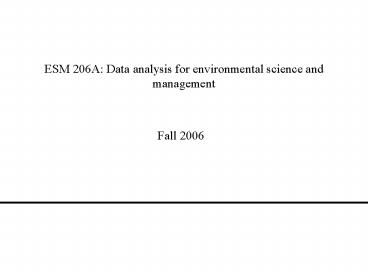ESM 206A: Data analysis for environmental science and management - PowerPoint PPT Presentation
1 / 21
Title: ESM 206A: Data analysis for environmental science and management
1
ESM 206A Data analysis for environmental science
and management
- Fall 2006
2
Ecological Effects of Nuclear Power Plants
- Nuclear reactors require cooling water to take
heat away from the fission reaction. - The San Onofre power plant discharges its cooling
water to the ocean. - An environmental defense group claims that if the
plant increases the local water temperature above
56 ?F, certain sensitive species will die. - Historical data reveals that the mean water
temperature in July is 50 ?F, with a standard
deviation of 3 ?F. - You take samples each day, for six consecutive
days in mid-July, with the following results
(52, 58, 57, 60, 62, 51). - Has the power plant increased the water
temperature? If so, is the increase enough to
have ecological effects?
3
Acidification of Norwegian lakes
- The year is 1979. Concern is growing in Norway
about acidification of its lakes, and the
Norwegian government asks Britain and Germany to
reduce emissions of sulphur dioxide from their
power plants. In response, Britain demands proof
that their emissions are acidifying Norwegian
lakes.
- As science advisor to the Norwegian government,
you are asked to design a study to produce this
proof. - What questions do you need to answer?
- What data should you request be collected?
- How should you analyze those data?
4
What is statistics good for?
5
Enhance understanding
Make predictions
Estimate parameters
Describe patterns and relationships in data
Select models
Test statistical hypotheses
Test theories
Make decisions
6
COURSE OBJECTIVES
- To formulate qualitative questions about and
decision criteria for ESM as testable
quantitative models. - To select and use analytical tools to estimate
parameters of these models from data.
- To use the fitted models to answer the
qualitative questions. - To explain the results of the analysis in a way
that does justice to both unpredictability
(natural variability) and uncertainty (the limits
of the data).
7
COURSE FORMAT
- Lectures
- 2 per week
- Expected to attend all lectures
- Lecture material applied and motivated with real
environmental problems - Problem sets
- 7 altogether through year
- 2 this quarter
- Solutions provided
- Covers concepts techniques
- Work as many as you need
- Labs
- 1 per week. T.A. Marion Wittmann.
- In GIS lab.
- Instruction on using software discussion
clarification of lecture, homework assignments - Micro-Exams
- One with each problem set
- Open book, but once you start, no consultation
with other humans - Grade based on best 6
8
RESOURCES
- Costello Kendall, Data Analysis for
Environmental Science Management (on the class
web page Bren Library) - Texts in Bren Library
- Fox Applied Regression Analysis by John Fox
- Manly Statistics for Environmental Science and
Management by Brian Manly - Moore Introduction to the Practice of Statistics
by David Moore and George McCabe - Zar Biostatistical Analysis by J. H. Zar
- Class web page www.bren.ucsb.edu/academics/
course.asp?number206 - Class email list esm206_at_bren.ucsb.edu
- Software JMP, PopTools
- Installed on Bren computers
- Student edition of JMP may be available from
bookstore - PopTools available at http//www.cse.csiro.au/popt
ools/
9
EXPECTATIONS
- Of You
- Participate in class/lab
- Do readings
- Submit assignments on time
- Do your own work
- Be in class on time
- Of Ourselves
- Keep it interesting
- Introduce techniques with real-world examples
- Make ourselves accessible
- Make lecture notes available
- Provide solutions when work is turned in
- End class on time
10
WHAT YOU SHOULD ALREADY KNOW
- Simple data summaries
- Basic probability theory
- Properties of random variables
- The normal probability distribution
- Confidence intervals what they are, and how to
calculate them for means - Hypothesis testing
- T-tests
11
The plan for the year
- Fall (ESM 206A) 3 weeks
- How to draw inferences about statistical
populations (the truth) from statistical
samples (the data) - Making decisions using data
- Assessing the effectiveness of management
- Assessing impacts of anthropogenic activities
- Incorporating prior information into analyses
- Tools include
- Probability theory
- Hypothesis testing (t-tests and ANOVA)
- Resampling techniques
12
The plan for the year
- Winter (ESM 206B) 3 weeks
- Understanding the relationships between
continuous variables - CO2 emissions vs. gas price
- Eutrophication vs. nitrogen fertilizer input
- Using these relationships to predict the effects
of policy interventions - Using these relationships to rank the
effectiveness of various policy interventions - Primary tool is Ordinary Least Squares (OLS)
regression - Spring (ESM 206C) 4 weeks
- Various advanced topics, including other types of
regression, survey design and analysis,
multi-criteria prioritization
13
Environmental challenge
- The problem California gold miners in the 19th
century used mercury to help extract gold from
placer deposits. Much of this mercury was not
recovered, leading to substantial mercury
contamination of sediments near historic mine
sites. This mercury bioaccumulates in animals,
ultimately threatening ecosystems and (through
fish contamination) human health.Your job
Characterize the level of mercury contamination
in the soils at a former mine site.
14
Populations and samples
15
Heres some data
- 0.853511661, 0.391905707, 0.143344303,
0.198267857, 0.266572367, 0.327306702,
0.834747834, 5.32261822, 0.817037696,
0.157247167, 0.328456677, 3.793153524,
0.513433215, 0.502938253, 0.733454663,
0.279345254, 0.95247347, 0.742740502,
0.178309271, 0.469049646, 0.764546106,
1.819858816, 0.830187557, 0.369993886,
0.644729374, 0.841576129, 0.734056277,
0.773035692, 0.810722543, 0.357449318 - The mean of the data is 0.858 the standard
deviation is 1.08 the sample size is 30.
16
Look at the data
17
The problem with histograms
18
Dot-plot
19
Cumulative density function
20
How well does the sample statistic estimate the
population parameter? Insights from Resampling
21
Distribution of sample means































